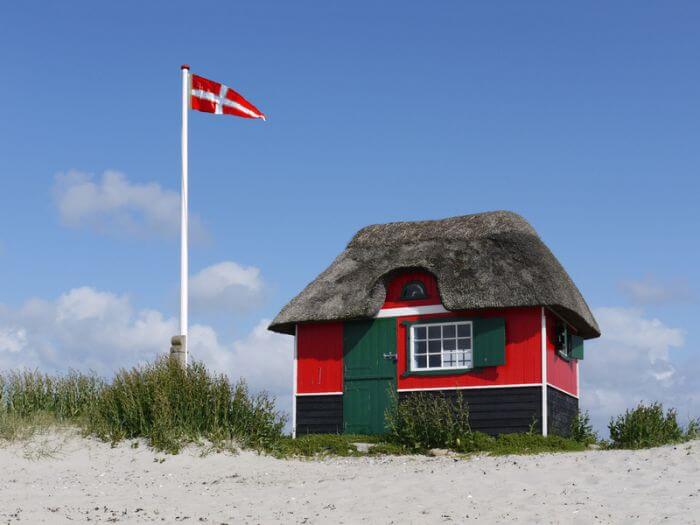Is Danish hard to learn? You may have heard that Danish is a difficult language. But who is actually to decide that?
It has never been easier, more fun or more rewarding to learn Danish than now! And it's not as hard to learn as it first looks.
In fact, despite a few tricky areas such as word gender, pronunciation and word order, Danish is actually one of the easiest languages for English speakers to learn.
By the end of this post, you'll have an idea of some of the harder aspects of Danish as well as what's easy. So let's get into it: is Danish hard to learn?
Pro Tip
By the way, if you want to learn Danish fast and have fun, my top recommendation is Danish Uncovered which teaches you through StoryLearning®.
With Danish Uncovered you’ll use my unique StoryLearning® method to learn Danish through story…not rules. It’s as fun as it is effective. If you’re ready to get started, click here for a 7-day FREE trial.
Table of Contents
Why Is Danish Hard To Learn? 3 Exciting Challenges

Danish offers its own unique use of words, letters, pronunciation and compositions.
Let's take a look at three of the most fun challenges when learning Danish:
1. Gender: The Danish language uses two genders. However, neither of them are masculine, nor feminine.
2. Vocabulary and Danish pronunciation. Danish has a large vocabulary, a slightly expanded alphabet. So many of the words have different meanings compared to English. This is also what makes Danish fun to learn.
3. Comprehension: Listening and reading comprehension can be difficult at first, as the word order in Danish is much different than English. You'll discover these differences too.
You'll see that while each of these aspects of Danish seem hard, you can master them.
Danish Word Gender

Danish differs from most other languages by partly using two different genders, but especially by not dividing those two genders into masculine and feminine.
When gender in Danish isn't used to tell whether we are talking about, for example, a male or female person, it may well create some confusion.
However, there's no need to panic, because you can learn it. The good news is that after all there aren't three genders as in German. And if you like to engage in problem and puzzle solving, the process can even be fun and entertaining.
So let's take a look at the two genders in Danish grammar, which are common gender (joint-gender) and the neuter (non-gendered).
Common Gender

Common gender sets en (a) in front of the nouns. Common gender words are living beings.
Eg:
- En dreng (a boy)
- En pige (a girl)
- En mand (a man)
- En dame (a woman)
- En hund (a dog)
As you probably notice, the gender of the person (or animal) doesn't depend on whether the person himself is of male or female sex. In Danish grammar, almost all living beings are common gendered.
Common gender makes up approximately 75% of all Danish nouns. When in doubt, the common gender is your safest choice.
Other words of common gender, are often words;
- from nature: en blomst: (a flower), en å (a stream), en banan (a banana), en gren (a branch)
- that end in –else: en overraskelse (a surprise), en forfremmelse (a promotion)
- that end in –ence or –ance; en konference (a conference), en ambulance (an ambulance)
The challenge is that the rules around the genders actually function more as guidelines than actual rules. Often, obvious common gender words choose to designate themselves as neuter. Even if there is no logical explanation.
This is one of the quirks of the Danish language.
So let's take a look at some examples of the common gender partner in crime in the Danish language gender system, namely neuter.
Neuter Gender

We use neuter gender when we put et (a) in front of the nouns.
Neuter words are often words that denote physical, inanimate things, e.g.:
- Et hus (a house)
- Et brød (a bread)
- Et glas (a glass)
But again – this is more of a guideline than an actual rule.
Other typical neuter words are places where you can stay, e.g.:
- Et distrikt (a district)
- Et land (a country)
- Et kongedømme (a kingdom)
- Et bageri (a bakery)
- Et universitet (a university)
Don't despair if you find it difficult. Try using these guidelines:
1) Common gender (en) makes up about 75% of all Danish nouns. When in doubt, choose en in front of your noun. That way you hit right 3 times out of 4. That's a pretty good statistic!
2) If you like structure, learn the guidelines so that you are able to make logical choices.
3) Watch Danish movies, listen to Danish podcasts, etc. Leaving aside the guidelines, choosing the right gender is very much about immersion in Danish. If you learn best by listening, this could be the way for you.
Still in doubt? Take your best guess! If you get it wrong, don't worry.
It might sound a little goofy if you choose the wrong gender, but no one will raise an eyebrow over it (so don't let the grammar villain tell you otherwise!). On the contrary, the Danes are often impressed by other people who make an attempt to learn their language.
Danish Vocabulary & Letters

The Danish language has an enormously exciting and wide vocabulary that can sometimes seem strange. The same words can mean completely different things in Danish and English.
And then there are three special letters that are quite unique to the Danish language. Let's take a look here.
Words With Multiple Meanings
Danish has many of its own words that make it unique. The vocabulary is very rich and varied, allowing you to express a whole bunch of different emotions and ideas in just one word.
For example, the word Hygge has a very special shade of well-being and closeness that does not exist in the same way in English.
Snakke means to talk, but it also has a more informal nuance, so it's often used to express having a conversation.
Another little quirk you will also often run into is that the same Danish word can often mean two very different things.
Take for instance the word Bønner which can mean both “beans” and “prayers”. Two words that have nothing to do with each other, but are nevertheless written and pronounced in exactly the same way.
The Danish language is rich in words that have double meanings, and for non-native speakers of the Danish language it can create some funny experiences.
Take a look here:
- Okse (an ox / to work hard)
- Bakke (to back up / a tray / a small hill)
- Banker (banks / to pound on)
- Skovl (a fool / a shovel)
- Hænder (hands / happens)
- Stole (chairs / trust)
The Danish language is full of these words of different meanings. And of course fart in Danish, means “speed”. That has the potential to create some confusion!
The Three Special Letters, Æ, Ø And Å

Danish has 3 super cool – and probably some of the most fun letters there are, namely: Æ, Ø and Å!
Æ (pronounced ‘eyh’) is a combination of A and E that you find in words like æble (apple), æsel (donkey) and ægteskab (marriage).
Ø (pronounced almost as ‘er’ in the word “better”) is an O with a dash through it and a combination of O and E. The probably most popular word starting with Ø in Danish is the word øl (beer).
Also the letter ø it is a word in itself. It actually means “Island”.
And finally, A and O, joined in holy matrimony gives us the letter Å (pronounced a bit like ’O’ in “open”).
These three letters may sound a little different in English, but they can easily be learned. And they help make Danish even more fun and interesting to learn!
The Danish R
Mastering the Danish ‘R’ may seem like a daunting challenge for English speakers, but with a little practice and determination, you can make this letter part of your linguistic repertoire.
The sound of the Danish ‘R’ is softer than the rolling ‘R' in Spanish or the throaty ‘R' in French. More like kind of a soft hum.
With regular practice, you will be able to say Danish ‘R’s in no time!
Danish Word Order

If you're learning Danish, you've probably come across its unique sentence structure and word order? If not, let's take a look at it.
In Danish, the subject (e.g. a person or a thing) usually comes before the verb (i.e. the act itself). This is in many areas the same in English when you need to ascertain something or make a statement or observation.
An example could be:
- Hun går indenfor (she goes inside) which is the same in both Danish and English.
The funny thing now is that the structure of Danish sentences often changes depending on the situation.
Questions, But In Reverse

When the Danes, ask a question, they'll swap the subject and the verb. In English you could ask, “is she going inside?”. In Danish, it will look like this:
- Goes she inside?
You may also notice that Danish does not use “to do” to form questions in either the present or the past tense. In Danish, the verb is conjugated directly, briefly and precisely:
- Does she go? = Går hun? (literally: goes she?)
- Did she go? = Gik hun? (literally: went she?)
Here's how you can learn Danish word order:
The key to mastering Danish word order is to be aware of the context. Ask yourself if your sentence is a statement or a question, then choose whether you should have the action (verb) before or after the person, animal, or thing (subject).
If you're looking for a fun and easy way to learn Danish sentence structure, why not start by writing what you want to say (or ask about) in English and then use your new found knowledge to translate it into Danish?
This can be a both fun and an effective way to practise and learn word order!
And of course, if you apply the StoryLearning method and read in Danish, word order will become second nature in no time, as you'll absorb it through immersion in short stories in Danish.
FAQs About Is Danish Hard To Learn?
How long does it take to learn Danish?
According to the Foreign Service Institute, Danish is actually one of the easiest languages to learn.
Along with languages like Italian, Spanish, Portuguese, and Romanian, learning Danish is estimated to take 24 weeks.
This is far less compared to other languages, with an estimation of 36, 44, and even up to 88 weeks of practice and training.
Is German or Danish harder?
German and Danish are both Germanic languages, like English, but German is generally considered harder for native English speakers to learn.
According to the Foreign Service Institute, Danish can be learned in as little as 24 weeks, while German takes 36 weeks to master.
The complexities of German grammar go someway to explaining why German is a bit harder.
German has three grammatical genders (masculine, feminine, and neuter) while Danish only has two (common and neuter).
Some other tricky features of German are its case system (nominative, accusative, dative, and genitive), and strong/weak adjective declensions.
German word order can also be complicated due to verb placement rules (e.g., in subordinate clauses, verbs often go to the end of the sentence).
In contrast, Danish has no case system for nouns, and verbs don't change according to person (e.g., “I am” is the same as “she is” — both are er). The word order is fairly similar to English, though it does have some quirks in subordinate clauses.
That said, some may consider German easier to learn because it's much more widely spoken and there are a lot more learning materials. This makes it easier for you to immerse yourself in German and practise it.
But ultimately, which one is easier for you to learn really depends on how motivated you are to learn it. So find your why first and then start learning.
What is the hardest part of learning Danish?
Danish pronunciation is often considered to be the hardest part of learning Danish.
For starters, the Danish alphabet has three extra letters you'll need to learn to pronounce – Æ, Ø and Å.
Æ (pronounced ‘eyh’) is a combination of A and E that you find in words like æble (apple), æsel (donkey) and ægteskab (marriage).
Ø (pronounced almost as ‘er’ in the word “better”) is an O with a dash through it and a combination of O and E. The probably most popular word starting with Ø in Danish is the word øl (beer).
Also the letter ø it is a word in itself. It actually means “Island”.
And finally, A and O, joined in holy matrimony gives us the letter Å (pronounced a bit like ’O’ in “open”).
Another tricky letter is the Danish ‘R'. The sound of the Danish ‘R’ is softer than the rolling ‘R' in Spanish or the throaty ‘R' in French. More like kind of a soft hum.
Here are some other features of Danish pronunciation that make the language both tricky to understand and pronounce
Soft Consonants: Danish is known for its “soft” consonants. For example, Danes pronounce the “d” softly or almost not at all, particularly in words like mad (food), where it sounds more like “ma.”
Stød: Danish features a glottal stop called stød, which is a slight constriction of the vocal cords that can change the meaning of words. You distinguish the words hun (she) and hund (dog) thanks to the stød.
Vowel Reduction: Danish has many vowel sounds. And Danes don't pronounce these sounds clearly in casual conversation. So it can be hard for Danish learners and even speakers of mutually intelligible languages like Norwegian and Swedish to catch what they say.
Is French harder than Danish?
According to the Foreign Service Institute which provides language training to US government employees, Danish takes 24 weeks to learn while French takes 30 weeks. These estimates are averages for native speakers of English.
So although Danish may be slightly easier to learn than French how easy it is for you to learn either language depends on a few factors.
For example, if you've already learned another romance language like Spanish or Italian, then French will probably be easier for you to learn than Danish.
Conversely, if you already know a bit of German this may help you pick up Danish as German has influenced Danish over the centuries. That said, Old Norse, the language of the Vikings which became Danish, also had an impact of English.
French is also much more widely spoken than Danish so it may be easier to find materials for learning French or people to speak to. Then again, even if there are no Danish speakers in your area, you can always find some online.
Ultimately, the language that's easiest for you is the one that you're most motivated to learn, no matter what official estimates say.
So, Is Danish Hard To Learn?

Is Danish hard to learn? Quite the contrary, particularly for native speakers of English.
In spite of the odd gender system, the multiple meanings of words, and the funny letters, according to the Foreign Service Institute, Danish is actually one of the easiest languages to learn.
Along with languages like Italian, Spanish, Portuguese, and Romanian, learning Danish is estimated to take 24 weeks. This is far less compared to other languages, with an estimation of 36, 44, and even up to 88 weeks of practice and training.
So, if you're eager to start learning Danish, what’s keeping you? Start today! If you need some more motivation, check out these 11 incredible reasons to learn Danish.
And to make your Danish learning journey as easy, fun and effective as possible, follow the rules of StoryLearning and read short stories in Danish.

Olly Richards
Creator of the StoryLearning® Method
Olly Richards is a renowned polyglot and language learning expert with over 15 years of experience teaching millions through his innovative StoryLearning® method. He is the creator of StoryLearning, one of the world's largest language learning blogs with 500,000+ monthly readers.
Olly has authored 30+ language learning books and courses, including the bestselling "Short Stories" series published by Teach Yourself.
When not developing new teaching methods, Richards practices what he preaches—he speaks 8 languages fluently and continues learning new ones through his own methodology.










































